Blogs & Articles: The IT Security Guy v A Random Lawyer: Who Is Satoshi Again? 🔗 10 weeks ago

- Category: Blogs & Articles | MyLegacyKit on Medium
- Author(s): MyLegacyKit
- Published: 16th February 2024 22:52
The COPA v Wright trial saw an epic battle about the Bitcoin source code on Valentine’s Day (February 14th of 2024). A witnesses’ report.

Written by Arthur van Pelt
ABOUT EDITS AND UPDATES to this article: as more material may become available after the publication of this article, it could have edits and updates every now and then. In that sense, this article can be considered a work in progress, to become a reference piece for years to come.
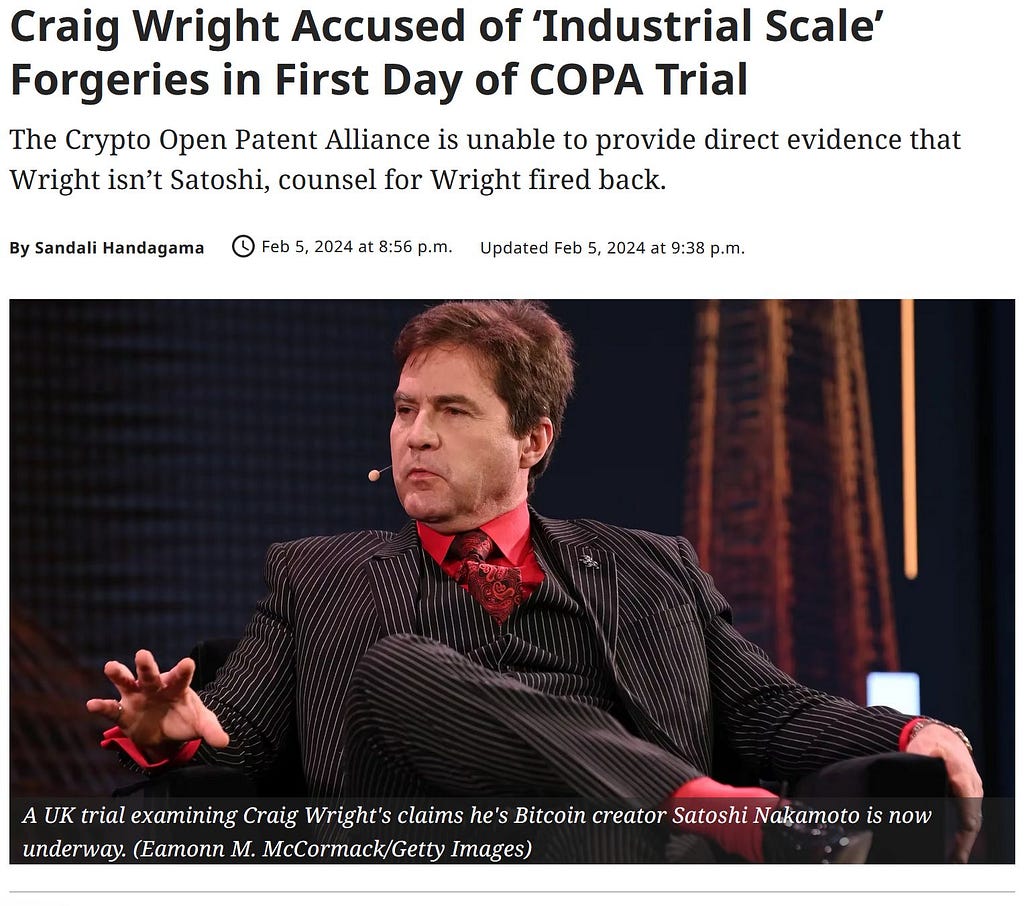 Source: CoinDesk
Source: CoinDesk
The tone is set straightaway on February 5, 2024 or Day 1 of the COPA v Wright trial, and indeed, all of the 7 days that followed with Craig Wright on the stand had a firm focus on the numerous tampered, altered, forged evidence that he had provided so far to COPA over the course of the lawsuit.
I’ve already done a Madden50 article and a Madden20 article about these forgeries, so the reader who didn’t attend the trial live in the court room in London, or who had not watched the live stream with the provided video link, might still have a pretty good idea what these days have looked like: Craig Wright telling all kinds of fairy tales about being hacked, his counsels who didn’t perform as instructed, third party laptops that had been tampered, him not running email accounts and private blogs, Citrix environments with copy-paste and other technical issues, etcetera, etcetera. And, on a rare occasion, Craig Wright admitted that he had been fooling around with evidence himself too.
In yet another stunning twist during trial, Wright admitted to the court that some of the documents he presented supporting his claim as Satoshi Nakamoto were indeed forged, a revelation that once again sent a wave of disbelief through the courtroom. (Forbes)
And then, Wednesday February 14, 2024 (Trial Day 8) arrived.
Many in the Bitcoin community following the Craig Wright saga know that Craig Wright cannot code, while for example Gavin Andresen, who has been coding on Bitcoin alongside Satoshi Nakamoto for a considerable timeframe, considers him a top 10% coder. Now irony has it that Craig Wright’s own forensic expert in the Kleiman v Wright lawsuit, AlixPartners’ Kevin E. Madura, wrote a forensic report released April 10, 2020 about Dave Kleiman.
“For this report I was asked to inspect certain documents and testimony and provide my opinion on whether the decedent, David Kleiman, had the requisite skills and experience to have written the original Bitcoin core software application released in 2009.”
Of course, Kevin Madura had to make a comparison with the real Satoshi Nakamoto, who is described by him as follows.
“A review of the original Bitcoin code shows that it was written by somebody with deep expertise and experience in the C++ language. In fact, world renowned C++ coder Gavin Andresen, the lead programmer on the Bitcoin project development team for at least four years, who routinely interacted with Satoshi until he stepped away, and who is intimately aware of Satoshi’s code writing skills referred to him as “definitely a top 10 percent programmer” (Andresen depo at 210:3). Naturally it would be expected that someone in the top 10 percent of a field would have extensive experience and background in activities directly related to that field. The expertise demonstrated in the original Bitcoin code goes beyond what is expected by even a typical programmer.
Development of bitcoin required a deep fundamental understanding of cryptography as well as advanced knowledge of data structures, programming algorithms, networking, computer hardware, and specialized programming techniques. The expertise required to write C++ code that reflects this knowledge is difficult to attain and would many require years of hands on programming experience and training.
Other industry leading programmers have also made similar public assessments. Dan Kaminsky, a leading Internet-security researcher, is famous among hackers for discovering, in 2008, a fundamental flaw in the Internet Domain Name System which would have allowed a skilled coder to take over any Web site. He is also regarded as one of the world’s best experts for testing software errors and weaknesses. In July 2011 he dug deeply into the Bitcoin software in an attempt to uncover its weaknesses.
Kaminsky found none he could exploit. This attempt is recounted in a New Yorker article, in which he was interviewed on the subject by the author, Joshua Davis. In this same article, Kaminsky, after noting that the programming style was dense and inscrutable is quoted as claiming, “the way the whole thing was formatted was insane. Only the most paranoid, painstaking coder in the world could avoid making mistakes.” He then went on to proclaim, “He’s a world-class programmer, with a deep understanding of the C++ programming language. He understands economics, cryptography, and peer-to-peer networking.”
 King’s Counsels Hough & Gunning (meme Skive)
King’s Counsels Hough & Gunning (meme Skive)
Back to the COPA v Wright trial. On this day, Valentine’s Day to add another touch of irony, Gunning KC took at some point over from Hough KC for a little but spectacular session with Craig Wright about the Bitcoin source code as released by the real Satoshi Nakamoto in the early days.
Several people witnessed what happened, either from inside the court room or on the provided video link. What follows is what they reported on social media or in the press.
- 1. WizSec Bitcoin Research
- 2. Dr Tufty Sylvestris
- 3. BitMEX Research
- 4. Artie Fan Belt
- 5. What The Finance
- 6. Jason Deane
1. WizSec Bitcoin Research
“Late summary of COPA v some IT security guy, day 8 (Wednesday): 🧵
Wright’s worst day so far. Until now he’s only been asked about his own narrative, but today he was tested on his knowledge of C++ and the Bitcoin code, objective things you can’t just lie your way through.

Yesterday Wright asserted that he’d never had anything to do with a particular email account on a domain owned by McGregor. Hough shows him an employment contract between Wright and McGregor’s company. Wright denies it’s his signature and says he didn’t pay any tax. 🤨 Wright says he’s not aware anyone discredited the Sartre blog post, as he never reads anything. He’s also never used Reddit. Starts ranting about other people trying to keep him down, so he keeps getting degrees. Told to stop; “we’ve got to make some progress today.” Hough pulls up internal emails about McGregor and Ayre panicking over the invalid signature, and Craig replying “the wrong one was uploaded”. Wright suggests that’s not him but someone else having taken over his email.

Wright says anything that comes from “compromized staff computers” is unreliable, so he’s asked if that includes his reliance documents which is also from other laptops. Wright says no, he’s intentionally using them as evidence of having been manipulated. 🤡 That Stefan Matthews testified to the authenticity of those emails doesn’t matter he says, because Matthews didn’t know McGregor had taken over Wright’s email accounts. That “the wrong copy was uploaded” email was meant to somehow frame Wright. Of … something.
Claims McGregor threatened him that if he didn’t do what he was told, McGregor would destroy him and his family, leading to Wright trying to kill himself. (Rich coming from Wright, who has infamously gloated that he wants the Core developers and their families destroyed.) Wright said he would have happily signed so long as he could prove his work first. Well, he’s submitted hundreds if not thousands of documents and several witnesses he says is proof of everything, so are we getting any closer to signing anytime soon? Wright said he couldn’t have written emails repeatedly promising to deliver signatures because he was traveling from Paris at the time. One of the emails says “I’m en route from Paris”. Wright says he couldn’t have written it as he was inside the Eurostar tunnel.
Wright repeats that if he had signed with Satoshi’s keys, then no one would ever have looked at any of the work he’s done. But it’s of course the other way around: one of the main reasons anyone would particularly care about Wright’s work is if they thought he were Satoshi! There are a lot of emails between Craig, his wife, McGregor and others about how Craig is going to provide signatures. Wright says all the emails from him and his wife must have been impersonated by McGregor. Hough points out Wright has never claimed this before. Wright notes several of the emails are inconsistent with claims Wright made elsewhere, so therefore they can’t have been written by him. It’s definitely not because Wright is bad at keeping his lies straight!
 Source: Twitter (not part of WizSec’s original thread)
Source: Twitter (not part of WizSec’s original thread)
Wright denies the old PGP key from https://bitcoin.org was Satoshi’s, says @marttimalmi put it there in 2011 replacing the real one. Wright keeps being willfully obtuse about key identities to try to derail the questioning, even after the judge steps in. Wright claims Satoshi’s PGP key was actually embedded in Vistomail and that he never possessed the private key. This isn’t a thing and just an excuse for not having something the real Satoshi ought to have, and besides, the key UID is “satoshin@gmx.com”.
Madden has actually authenticated that the PGP key we have is the same one uploaded to https://bitcoin.org in 2008 and it was directly referenced by Satoshi. Wright refuses to accept this and calls Madden’s analysis wrong and “just an opinion” unsupported by any evidence. Wright explains that when you use GPG to create these keys, you can put in any email address you want, so it isn’t strange that the email address mismatches. But he just claimed it was created and kept by Vistomail, not by him using GPG! Wright rants about backdating, that he set the date on the key back to the beginning of the project and that “he does this all the time”.
His argument appears to be that metadata dates can’t be trusted, at least definitely not in any of his files? Hough asks if Wright accepts that Satoshi’s PGP key could be used as both a signing key and encryption key. Wright says no, that it would be very bad practice. Asked why he’s never mentioned backdating before, Wright answers a different question instead. Trying to explain away a legitimate email with @marttimalmi mentioning Satoshi’s PGP key, Wright says he recreated a different key with different algorithms using the same private key. (Again, he claimed that Vistomail had the private key and he never did!)
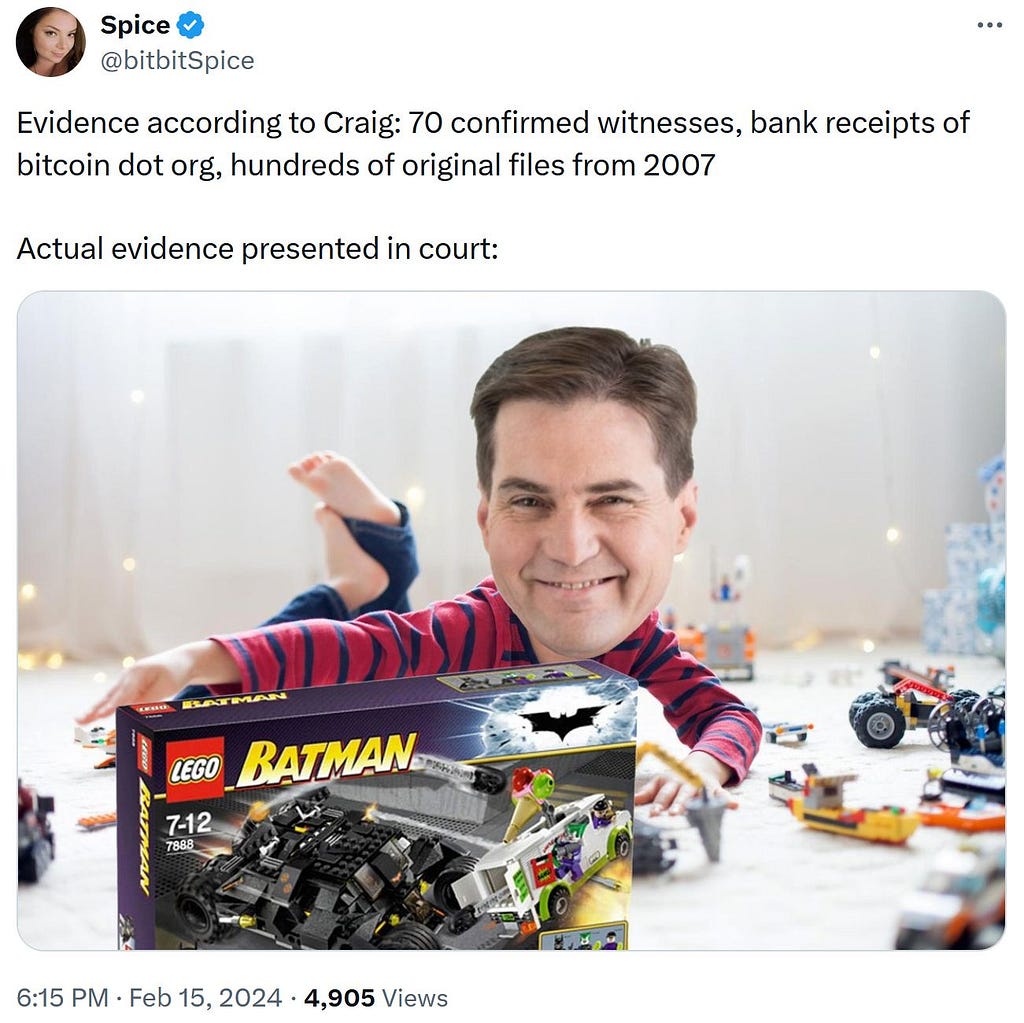 Source: Twitter (not part of WizSec’s original thread)
Source: Twitter (not part of WizSec’s original thread)
Regarding the key signings, Wright is saying that if your wallet software successfully validates the blockchain then it cannot have been modified. This is a bald-faced lie; you can trivially leave the consensus code intact while modifying other things (like message signing). Claims the BBC intentionally lost their footage of Wright performing the key signing on his screen, says @ruskin147 is “very pro-BTC” and incredibly biased against Wright, because BSV handles 99% of all blockchain transactions everywhere. 🤡 Wright disagrees that “bitcoin-cli” is the name of the command being executed in a supposed key signing. (The suggestion seems to be that it would have been easy to swap this out for another script, hence why Wright preemptively rejects that notion.)
Asking why Wright didn’t just sign a message and let someone else freely verify the signature on their own (like it’s supposed to work), Wright says then he wouldn’t have any control over the signature and it might be released to the public. Hough asks why they arranged signings for journalists if the point wasn’t to publicly confirm possession of the keys. Wright again says that then they wouldn’t have looked at all his degrees and papers! Describing the Gavin signing, Wright now says both he and Gavin took turns using the new laptop and that no one was ever alone with the laptop. (Wright previously claimed Gavin did everything; Gavin has always claimed Wright did everything.)
Wright says it would have been “incredibly difficult” even for someone of his experience to stage the signing session. (Could God create a boulder so heavy He Himself could not lift it?) Wright bemoans that none of the experts in the case are qualified to opine on how the signing session could be faked. Why didn’t he request such experts then? He insists he did, but I guess his lawyers conspired with the Blockstream lizard cabal against him. Insists Gavin saw everything, says Wright sometimes went off leaving Gavin alone with the computer but never the other way around. But wait, just minutes earlier he insisted *neither* of them were ever alone with the computer!? 🤔
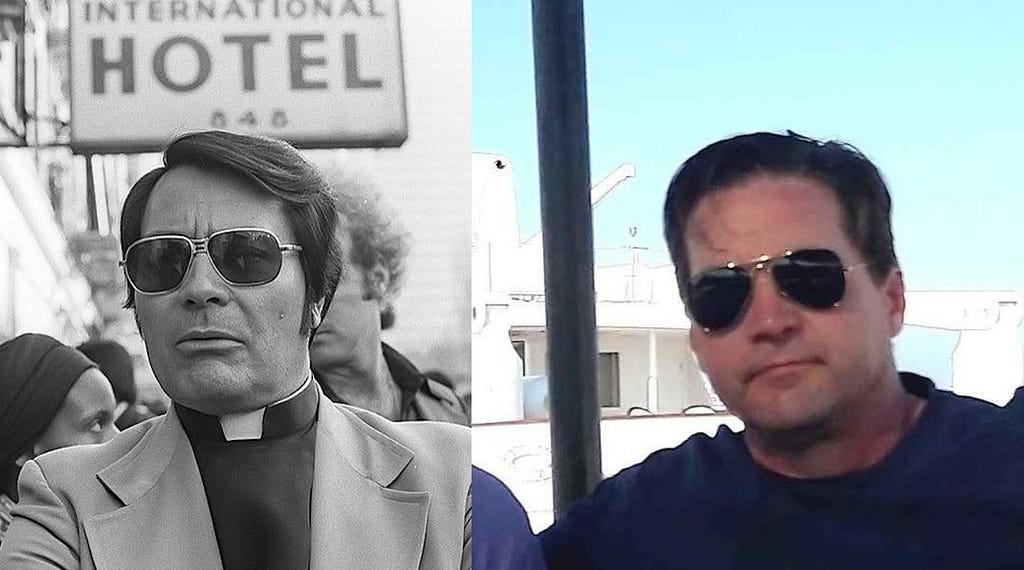 Vibes. (not part of WizSec’s original thread)
Vibes. (not part of WizSec’s original thread)
Wright says he destroyed hard drives with keys in a fit of irrational autism-fueled rage, whereas in the @hodlonaut trial he said he did it for a very specific intentional purpose. Wright refuses to acknowledge these are two very different claims. Wright recasts a meeting with Mike Hearn set up for Hearn to judge for himself whether Wright was Satoshi as instead one where Hearn was trying to steal Wright’s super genius patent ideas. Asked to confirm that he asserts intellectual property rights over the whitepaper, the Bitcoin file formats, the Bitcoin name and the Bitcoin blockchain, Wright says no, the Bitcoin name is a trademark. (Trademarks are intellectual property.)
Hough brings up Calvin’s funding of Wright’s litigation, cites an email “every cent spent on your cases is me pissing away my kids’ inheritance”, Wright says nah-uh not a funder. Wright says he’s sold his shares for funding. Wright says he never wanted to be known as Satoshi, he just wanted to be left alone and his invention left untouched. Wright also previously said he told “everyone” he was Satoshi, at least 3–400 people in Australia alone. Wright’s claimed 70–100 witnesses have dwindled down to just a handful of dubious characters; claims the others are too old or have received death threats. Can’t get hold of any of the people he claimed to have pitched Bitcoin to in 2008–2009.
Not a single private Satoshi email produced, no knowledge of communications, no cryptographic proof. Meanwhile, volumes of inauthentic evidence, and constantly blaming lawyers and conspiracies. Wright says he has thousands of patents; “that in itself is evidence”. Wright confirms that he will keep insisting he’s Satoshi even after this court finds he isn’t, and he’ll keep using the courts to attack people, though shifting mainly to patent trolling. (Wright is basically making the case to the court that he’s a vexatious litigant.) Switching now to cross-examination by the developers’ barrister, Alexander Gunning, and boy did he come prepared.

Starts by simply asking whether Wright is asking for monetary damages, but Wright keeps evading and saying it should be donated to charities until the judge forces him to answer the question, and Wright says that no, so long as they implement the changes he wants. The judge asks what these changes are, but Wright doesn’t have a list and says he’ll sit down with the devs and explain it in full, then starts listing money laundering, taproot, micropayments, terrorist funding, everything but the kitchen sink. 🤷♂️
Gunning gives Wright a brief history lesson in Bitcoin terminology, e.g. “Bitcoin Core” is from 2014 and “UTXO” is from 2012. Wright has used these terms in documents backdated to much earlier than that, so he insists they’re older. Gunning walks Wright through the CBlock::CheckBlock() function in Bitcoin’s main.cpp, and asks Wright simple yes/no questions about its functionality.
Wright initially follows along and tries to correct Gunning on details, but then Gunning drills deeper. Wright is asked what the CheckTransaction() function does; Wright says the transaction scripts (including signatures) have to be verified. Gunning points out that actually just a minimal sanity check is performed here; script validation happens elsewhere. Wright tries to suggest that the function calls other functions that in turn does the validation he said, but Gunning points out he’s just wrong about a pretty central part of the Bitcoin software. Wright says he’s just not being allowed to explain properly, but Gunning is not having it; *he* will explain it to *Wright*.
Proceeds to show Wright the *actual* code that handles transaction script validation. Wright starts saying gobbledygook suggesting that CheckBlock() magically includes all the other functions and doesn’t work if they’re not there. The judge, clearly better at C++ than Wright, says Wright will have to show where in the code he says those calls are. Gunning walks the court through the exact code path to get to the actual transaction script validation code, which is nothing like what Wright suggested. Wright is now just nodding along. The confidence has temporarily evaporated and he says he hasn’t looked at the code in years. Gunning discusses a code change, with Wright mostly following along. Wright agrees that this code (adding a separate CheckBlockHeader function) was not in Satoshi’s original code but introduced by the Core devs in 2013.
Gunning pulls up one of Wright’s reliance documents supposedly from 2008. It mentions “Bitcoin Core” and “CheckBlockHeader”. Wright suggests that it was for SPV and “meant to be implemented”. Says Gavin got a patch for it. He didn’t. Wright tries to talk about Teranode instead. Gunning pulls up another document supposedly from 2007. It mentions “UTXO”. Wright insists he used that term privately and people in his companies knew it, so if anything the term must have originated with him. Wright claimed in his witness statement that BTC restricted scripts by placing a maximum size of 520 bytes, with a GitHub link to the relevant change, introducing a MAX_SCRIPT_ELEMENT_SIZE constant.
 Source: Twitter (not part of WizSec’s original thread)
Source: Twitter (not part of WizSec’s original thread)
Gunning asks if Wright knows what “unsigned” means in the variable declaration, and presses him to explain. Wright says yes, basically it’s an integer with… it’s larger… I’m not sure how to say it. I’m not sure how to describe it. I know what it is. Gunning pulls up a C++ book to show that “unsigned” simply means it cannot be negative. (It’s literally in the name; no sign!) Wright’s says yes he knows *that*, he just didn’t think of how to say it in such a simple way. (Uh-huh.) If you’re not a C programmer, being unsure what an unsigned int is is kind of like a self-proclaimed Michelin star chef not remembering whether you use oil or water to make mayonnaise.
Wright momentarily confuses the change being talked about and claims it was one he was behind, but this one was done by @TheBlueMatt . Gunning points out that contrary to Wright’s claim it’s not actually adding the limit at all, it just names the constant for it. In the process Wright accidentally reveals he can’t read diffs; he thinks the plus and minus characters prefixing added/removed lines are part of the code. 🤦♂️
WizSec Bitcoin Research on Twitter: "TL;DR of day 8: Wow, Craig Wright absolutely cannot code. He didn't even know what an unsigned integer is!Even the judge is probably better at C++ than Wright! / Twitter"
TL;DR of day 8: Wow, Craig Wright absolutely cannot code. He didn't even know what an unsigned integer is!Even the judge is probably better at C++ than Wright!
Wright insists that Core still added the script limit, because it was originally intended to be temporary and so by leaving it in place they in effect “added” it. (This is the same kind of bullshit redefinition that has cultists arguing BTC is a fork from BSV.) Satoshi’s disabling (and Core’s never-reenabling) of certain OP codes is a favorite BSV talking point. Gunning quizzes Wright on why OP_LSHIFT was removed. Wright talks out of his ass that it hadn’t been security tested. It actually contained a crash bug, found by ArtForz. Wright says yes he originally disabled those OP codes but it was a patch sent to him. From whom? Oh, different patches at different times. (You wouldn’t know them, they live in Canada.)
Gunning shows Wright a code snippet “opcode == OP_CAT || …” and asks what the double bar is. “Concatenation”, Wright says. Gunning does a double take. Wright corrects himself to “concatenation for, like, ‘or’”. (The double bar is not concatenation.) Gunning then asks about OP_2MUL, which Satoshi also disabled, and Wright insists it should be enabled. Gunning points out it’s disabled in BSV; Wright had no idea and says it needs to be fixed ASAP. (So Gunning is now schooling Wright on how BSV works, too.) Gunning moves on to teach Wright about PGP subkeys, as Wright was clearly unaware that Satoshi’s PGP key contains a dedicated key for signing. (Wright insisted the PGP key couldn’t be used for signing and it would be inappropriate.) Gunning also points out Satoshi’s PGP key was created on Windows, whereas Vistomail (which Wright claimed created the key) ran on Linux. Wright just responds with “no it isn’t” to all of these points.
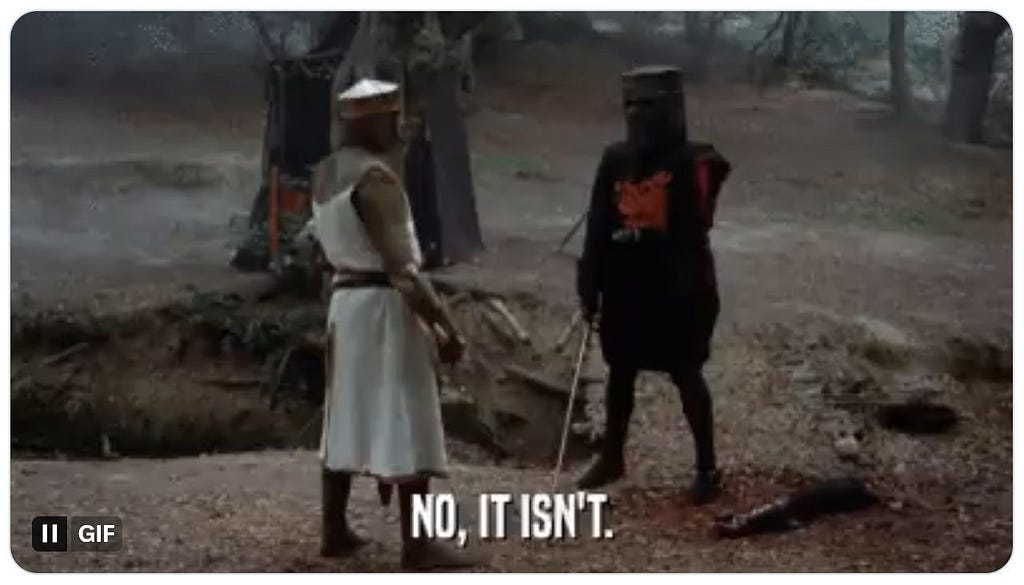
Most of the rest of the day is just Wright trying to untangle the stuff he got wrong in previous days’ testimony, and I don’t think it’s lost on the judge how effortlessly he pivots from one story to another with unflinching confidence. At the very end the judge takes over with his own questions for Wright: asking about Wright overriding dates in LaTeX, incredulity as to why “staff” would access and alter Wright’s whitepapers, and Wright saying he tries to hide IP assets from bankruptcies.
The judge asks about a contradiction in Wright claiming to have had all the IP locked up in trusts he couldn’t access, but he’s claimed to have kept working on that IP during many of those same years. The judge also presses Wright on his claim that CheckBlockHeader was part of the original Bitcoin, and asks if he’d find it in the original Bitcoin code then. Wright says no, because the SPV version wasn’t built yet. (But he previously said the SPV work actually came first!) The judge further presses Wright on the supposed 2008 document, noting that it mentions CheckBlockHeader in the *present tense*, not some future version. Wright says he writes lots of things in weird ways.”
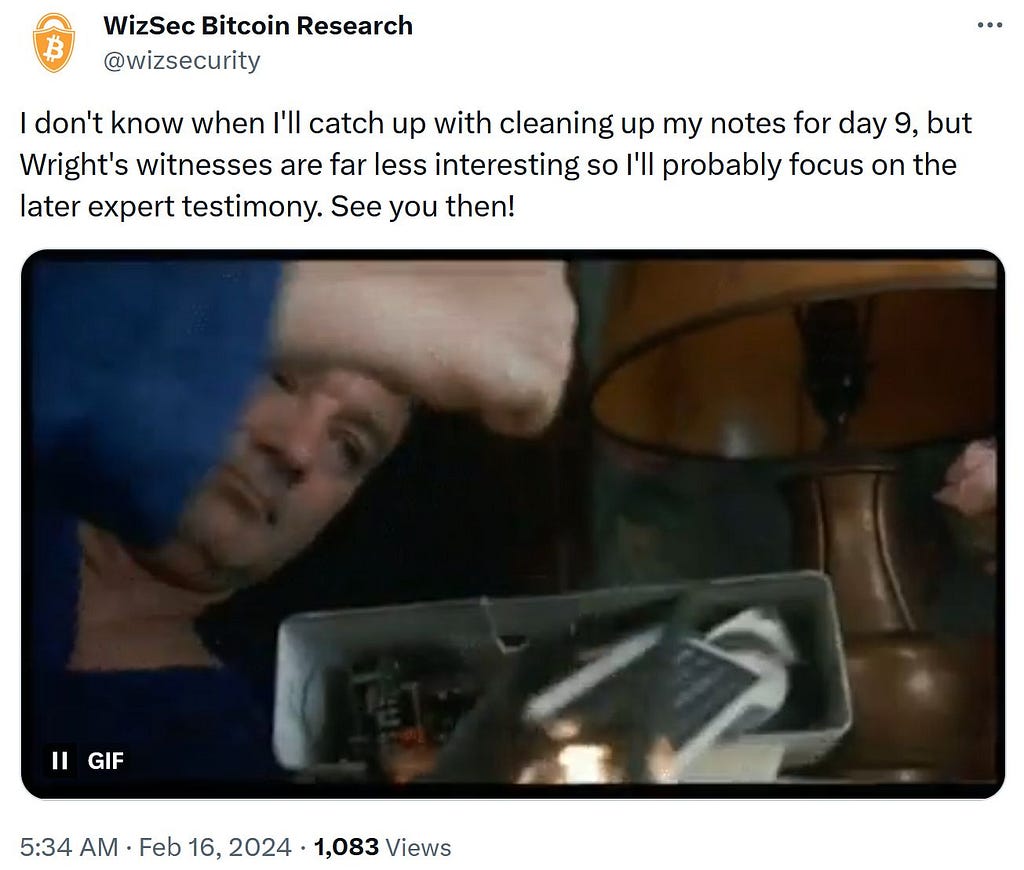 The last tweet from WizSec’s thread
The last tweet from WizSec’s thread
2. Dr Tufty Sylvestris
“CW: My premise isn’t that I want to prove I am Satoshi. I am Satoshi. I don’t want my life’s work misrepresented. I didn’t ever want to be Satoshi, I want to be left alone to invent. This week I have written 3 pay-tents. I’ve done this the whole time. I’m doing many degrees. I’ll hit 10,000 pay-tents and keep going. I’m a minister, a pastor, the only thing you should believe in is God. I just want my invention not to be misrepresented.
JH: Our position is that you have been misrepresenting yourself to be Satoshi.
JH: You wanted to get to 100 witnesses to support your claim. You have only 2 who claim to have had the white paper before its release — Matthews and your uncle.
CW: Matthews never provided funding for me. Ignatious Pang was involved. Rob (MacGregor) was involved. Dave Bridges, Mark Archibold.
JH: Nobody from BDO has been called.
CW: Neville is old, my uncle is poorly.
JH: Nobody from Microsoft or PornHub, nobody from your companies.
CW: I don’t have the files, nobody wants to be involved. Death threats and hate mail.
CW: I don’t have the originals. GMX was hacked, Vistomail was closed. Everything has been lost.
JH: You’ve never provided evidence in support of paying for the bitcoin domain name, nobody has kept a copy of an original paper, you have questioned the veracity of your own reliance documents, you have failed to provide cryptographic proof. There is just no basis for your claim to be Satoshi.
CW: (irrelevant waffle, pay-tents etc.)
[1000 pay-tents is not evidence of you being Satoshi Craig].
CW: If I don’t win this case, I will create more pay-tents.
JH: You have blamed failures on your lawyers. In Norway, you said your lawyers disregarded your instructions.
CW: They refused to run the case I wanted. I had to replace them (and still lost).
JH: Also in the McCormack case.
CW: Ontier didn’t do what I wanted.
Grabiner interrupts, asking for all this to be done in closing without the need to cross-examine.
JH: Based on other cases where you blamed your lawyers, if in this case you lose will you still maintain you are?
CW: Yes.
JH: Also for IP rights.
CW: Champagne case (this is a misunderstanding of the law relating to passing off). Taproot is infringing 3 pay-tents. European courts will start action on that. If I had to, I will force them to shut down. It will be a pay-tent case. If I lose this, there are 80 pay-tent cases already waiting. I don’t give a rat’s ass whether you believe I’m Satoshi.
JH: In conclusion: you are not the author of the white paper.
CW: I am the inventor of the timechain (waffle).
JH: It’s all a lie isn’t it?
CW: No it is not.
Robin Nakamoto on Twitter: "Mellor: "who set the date back?"Craig: "I did"Mellor: "Why?"Craig: "My Lord, I do this sort of thing all the times"Mellor: https://t.co/gnITtAwYFJ pic.twitter.com/28CdasTPys / Twitter"
Mellor: "who set the date back?"Craig: "I did"Mellor: "Why?"Craig: "My Lord, I do this sort of thing all the times"Mellor: https://t.co/gnITtAwYFJ pic.twitter.com/28CdasTPys
Judge: Mr Gunning.
Mr Gunning’s questions now for the Developers.
G: You seem to suggest that you were claiming to get billions of dollars in your claim form. Are you claiming any monetary remedies?
CW: Not directly. I will give every cent recovered to charity.
G: So you are?
CW: I will seek damages from losses.
G: Are you claiming a monetary remedy?
CW: Not to me. I don’t care if you like me or not. Pay my original offer and we’ll be happy.
Judge: Are they going to have to write a cheque for anything other than costs?
CW: If they implement the required changes, I will forego any money.
Judge: Where are these changes set out?
CW: British law (waffle). I will sit and explain. No more money laundering, no more Taproot, micropayments, no more terrorist funding.
Gunning is questioning CW about technical details of Bitcoin, including when the term ‘UTXO’ was first used (2012), which CW didn’t know, and functions in the software. He describes the check transaction function and asks CW what it involves. CW then goes on to describe checking a transaction involving scripts etc. Gunning then describes what the function actually does and it involves none of what CW just said, it’s just a simple 3 step preliminary check for a transaction.
CW stumped.
I can see this going on all day. Clearly CW doesn’t know the first thing about how the Bitcoin software works.
G: Do you want me to explain?
Oh dear.
CW tries to explain himself by not having looked at the code since 2017. “Do I remember all the functions off by heart? No”.
G: Satoshi would have remembered how that function worked.
I’m way out of my depth on the descriptions of various bits of code in the Bitcoin software, but I can see that Gunning is showing quite clearly that CW hasn’t the first clue. He doesn’t even recognise a moved bit of code being marked green on GitHub. “I don’t use GitHub” he says. Hmm.
Gunning has now caught CW out on the mention of checkblockheader in a Word document submitted as a reliance document by CW and claimed to be from 2008. The function was, however, not introduced until 2012 and by Pieter Wuile (who appears to be in court today).
CW again stumped.
The term UTXO was also not used until 2012, but CW has used the term in his reliance documents, together with reference to a UTXO pool, which also wasn’t referred to by that name at the time.
G: This is very compelling evidence that you incorporated elements that could not have possibly come from 2007–2008.
G: You forged these documents, didn’t you?
CW: I did not.
It took Hough 6.5 days to eviscerate Wright. Gunning has just done it in 20 minutes.
OMG, he doesn’t know what an unsigned integer is. Even I know what an unsigned integer is. I am assuming this is very very basic stuff.
I’m just going to watch this and enjoy it. He’s totally lost.”
 Source: Twitter
Source: Twitter
3. BitMEX Research
“Not only did CSW not know what an UNSIGNED INTEGER was, he also appeared confused by GitHub commits in quite a basic way. In 2013 @TheBlueMatt gave a name in the code to the max scipt element size, originally put there by Satoshi. CSW’s evidence wrongly claimed that @TheBlueMatt added the limit as a new rule. When questioned on it, CSW appeared confused by the meanings of the + and — signs at the start of the lines.
The conversation went as follows:
Alexander Gunning KC (For the devs): That identifies that max_script_element_size equals 520 right?
CSW: No, it says minus on that and plus on the other one.
Here is the commit from @TheBlueMatt which was being discussed.”

 Source: Twitter
Source: Twitter
4. Artie Fan Belt
“Craig is now being asked (by the lawyer of the Bitcoin developers) about the initial Bitcoin source code, line by line. 😬
Oh my god. This is EPIC. Craig Wright is being educated how CheckBlock works on request of Justice Mellor because Craig made several mistakes. 😂
YES. It happened. Craig Wright got completely stuck at a line in the code that he doesn’t understand:
‘static const unsigned int’
And Craig is now completely lost.
Game over.
The neverending silence of Craig Wright at the ‘static const unsigned int’ code, his handwaving that came to a grinding halt halfway in the air, then after another painful silence the humble admission that he doesn’t know how to explain it… EPIC.
Craig is now shown all the corners of the court room. The Bitcoin developers’ lawyer has almost completely silenced Craig Wright, who’s tone is now almost humble, only agreeing to the lessons that he’s being learned. What an amazing sight this is. History being made here!
Thanks to @bitnorbert we can still relive what Craig Wright was saying between the silences. Craig lost it at the question “do you know what unsigned means?”


#Faketoshi Fun Fact
In the initial release of #Bitcoin coded up by Satoshi Nakamoto, the ‘unsigned integer’ was used over 500 times. Yes, you read that correctly: over 500 times.
When asked in court, Craig Wright doesn’t know what an ‘unsigned integer’ is.
And this wasn’t even new info, I just found out. COPA might have seen this video, hence they put Gunning on it. 😂”
ᗪIGIᑎᗩᑌT on Twitter: "Craig Wright can't code. He did not create #Bitcoin He does not appear to know what signed/unsigned integers are.#BSV pic.twitter.com/wzaP4NNLz0 / Twitter"
Craig Wright can't code. He did not create #Bitcoin He does not appear to know what signed/unsigned integers are.#BSV pic.twitter.com/wzaP4NNLz0
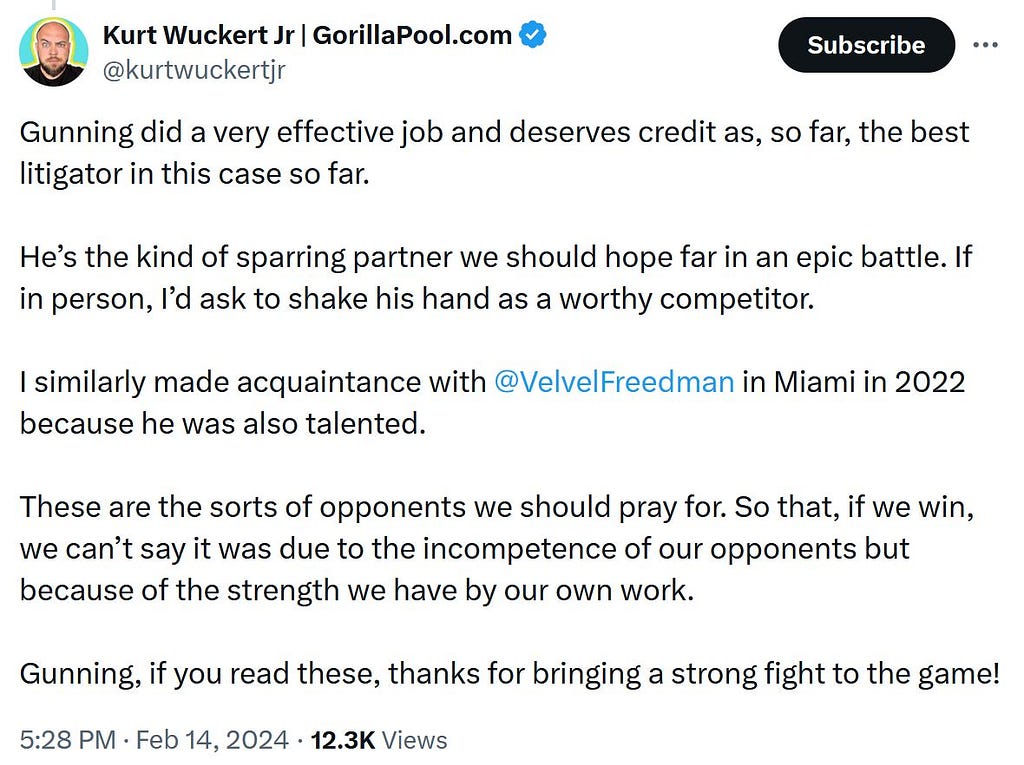 Even Craig Wright apologist Kurt Wucker was impressed. Source: Twitter (not part of my original thread)
Even Craig Wright apologist Kurt Wucker was impressed. Source: Twitter (not part of my original thread)
5. What The Finance
A few snippets from their article “IT Guy on Trial Leaves More Questions Than Answers — Day 8”. Here is how they picked up what Bitcoiner hodlonaut (well known for his almost 5 years long legal battle against Craig Wright in both Norway and the United Kingdom) shared about this remarkable moment of Craig Wright being grilled and torn apart in the court room about what should have been his absolute comfort zone: coding Bitcoin.
“Hodlonaut’s account of the trial’s start suggests a turbulent opening, with Craig Wright renouncing prior claims, repudiating blogs, and disavowing contracts, signature notwithstanding. Hodlonaut highlights Wright’s inconsistency, particularly his declaration that the very documents he selected to underpin his narrative are unreliable. Such a “strong start” seems laced with sarcasm, hinting at a self-sabotaging testimony.
The trial anticipates testimony from Marti and others whom Wright allegedly fabricated tales about. Hodlonaut expresses skepticism, pointing to a pattern of Wright blaming various individuals and “unprecedented phenomenons” for the contradictions surfacing against his evolving account.
The involvement of Calvin Ayre, a known supporter of Wright, was underscored in the courtroom by COPA, with Hodlonaut claiming to possess “hundreds of receipts” of Ayre’s active participation in Wright’s campaign against detractors, aiming to intimidate and set a legal precedent. Wright found himself outmaneuvered on technical knowledge of Bitcoin’s code by the developers’ barrister, a moment Hodlonaut relishes as “absolutely delicious.” Wright’s defense crumbled to a mere admission of forgetfulness due to the passage of time.
A telling exchange over GitHub left Wright’s familiarity with the platform in doubt, despite its use by BSV, the blockchain project he champions. His deflection to his team’s responsibility was met with disbelief and amusement by Hodlonaut. Judge Mellor’s direct questioning exposed Wright’s tendency to weave elaborate justifications more suited for sympathetic audiences than a legal tribunal. Hodlonaut’s commentary paints a grim picture of Wright’s performance, suggesting he grossly underestimated the courtroom’s discernment.
The judge’s parting words, as interpreted by Hodlonaut, carry an undertone of finality, perhaps an omen of Wright’s credibility crumbling under the weight of his own testimony. The use of a skull emoji underscores the perceived fatality of Wright’s case in the court of public opinion.”
hodlonaut 80 IQ 13%er 🌮⚡🔑 🐝 on Twitter: "Wright's defense to why he was wrong/ignorant on key parts of the bitcoin code:"I forgot, it's been a long time"😂 / Twitter"
Wright's defense to why he was wrong/ignorant on key parts of the bitcoin code:"I forgot, it's been a long time"😂
6. Jason Deane
 Image attached to Jason Deane’s tweet.
Image attached to Jason Deane’s tweet.
“Day 8 #copavwright trial, today’s reflections.
I’m going to be honest. I didn’t get much work done this afternoon, or make that many notes. I was open mouthed for most of it. History was made today.
This was very much a turning point in the trial and one I suspect #wright will not come back from, unless there’s some utter bombshell last minute reveal, Hollywood blockbuster style.
I can’t even summarize how bad it is for #wright, there are simply too many “gotchas” that stand out. I’ll do a couple of summary points here, but I really recommend grabbing a cup of tea and reading the transcript of the day by @bitnorbert, you really won’t be sorry.
Also check out
@hodlonaut
@WhatTheFinance9
@BitMEXResearch
@Arthur_van_Pelt
‘s commentary.
From this morning’s denial of his own signatures, contracts he entered into or email threads he was clearly part of, to not remembering (or even apparently understanding) key parts of what he claims is his own code, despite also claiming to have a photographic memory for such things (not people or names though, remember! lol!) it was total disaster for him from the moment court went into session.
Wright explained that his proof of him being #Satoshi is nothing to do with witnesses, paperwork or cryptographic keys (none of which he can actually present) but in in his 1000’s of unrelated patents (?) and the fact that no-one else has come forward.
Cool story, bro.
Although not central to the identity question, the fact that there was overwhelming evidence through multiple documents that Calvin Ayre DID in fact fund #CraigWright’s legal fees, it proved (as if we didn’t know already) that #wright will happily lie under oath on even the most provable, basic points.
And this is the man who wants to centralize, manage and control #bitcoin under his supervision according to his grand vision that he #craigsplained to Judge Mellor.
Oh dear God, the whole thing is madness.
Mellor himself had a few questions for #wright and, as ever, he went off on tangents and provided some very weak explanations for excellent, precise questions about IP and the Trusts. I think it’s safe to say Judge Mellor was not in agreement with those explanations, but I accept it is dangerous to speculate on such matters.
#wright has finished — for now — on the stand. Tomorrow we move to witness evidence.”
That’s all folks, thanks for reading!
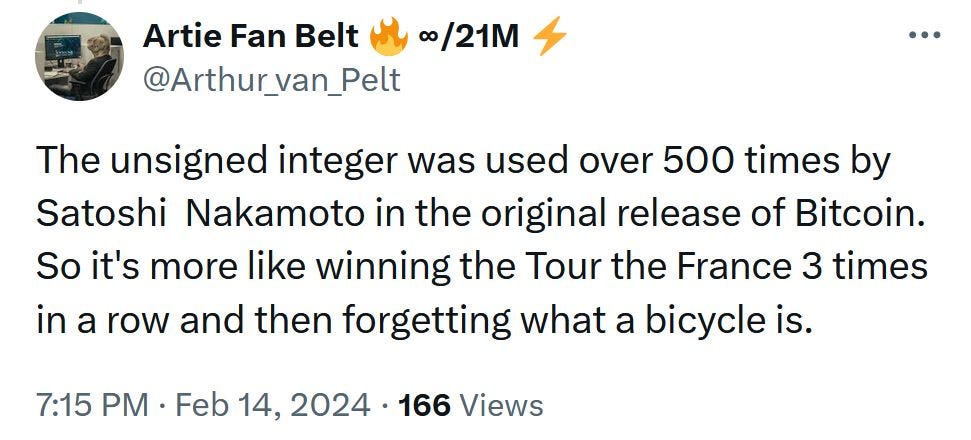 Source: Twitter
Source: Twitter






